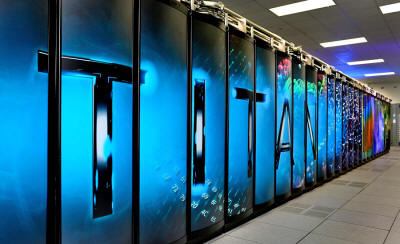The
U.S. Department of Energy’s (DOE)
Oak Ridge National Laboratory (ORNL) has launched a new era
of scientific supercomputing today with Titan, a system capable
of more than 20,000 trillion calculations each second - or 20
petaflops - peak performance by employing a family of processors
called graphic processing units (GPUs)
first created for computer gaming.
Titan will provide unprecedented
computing power for research in energy, climate change,
materials and other disciplines to enable scientific leadership.
Titan is now one of the world’s fastest supercomputers, joining
IBM Sequoia BlueGene/Q, also at 20 petaflops peak
performance.
Titan will be 10 times more powerful
than ORNL’s last world-leading system, Jaguar, while overcoming
power and space limitations inherent in the previous generation
of high-performance computers.
“Titan will allow scientists to
simulate physical systems more realistically and in far
greater detail,” said James Hack, director of ORNL’s
National Center for Computational Sciences.
“The improvements in simulation
fidelity will accelerate progress in a wide range of
research areas such as alternative energy and energy
efficiency, the identification and development of novel and
useful materials and the opportunity for more advanced
climate projections.”
The Cray XK7 system contains 18,688
nodes, with each holding a 16-core
AMD Opteron 6274 processor and an NVIDIA Tesla K20 graphics
processing unit (GPU) accelerator. Titan also has more than 700
terabytes of memory.
The combination of central
processing units (CPUs),
the traditional foundation of high-performance computers, and
more recent GPUs will allow Titan to occupy the same physical
space as its Jaguar predecessor while using only marginally more
electricity.
“One challenge in supercomputers
today is power consumption,” said Jeff Nichols, associate
laboratory director for computing and computational
sciences. “Combining GPUs and CPUs in a single system
requires less power than CPUs alone and is a responsible
move toward lowering our carbon footprint.
Researchers have been preparing for
Titan and its hybrid architecture for the past two years, with
many ready to make the most of the system on day one.
Among the flagship scientific
applications on Titan:
-
Materials Science:
The magnetic properties of
materials hold the key to major advances in technology.
The application WL-LSMS
provides a nanoscale analysis of important materials
such as steels, iron-nickel alloys and advanced
permanent magnets that will help drive future electric
motors and generators.
Titan will allow researchers
to improve the calculations of a material’s magnetic
states as they vary by temperature.
-
Combustion:
The S3D application models
the underlying turbulent combustion of fuels in an
internal combustion engine.
This line of research is
critical to the American energy economy, given that
three-quarters of the fossil fuel used in the United
States goes to powering cars and trucks, which produce
one-quarter of the country’s greenhouse gases.
Titan will allow researchers
to model large-molecule hydrocarbon fuels such as the
gasoline surrogate isooctane; commercially important
oxygenated alcohols such as ethanol and butanol; and
biofuel surrogates that blend methyl butanoate, methyl
decanoate and n-heptane.
-
Nuclear Energy:
Nuclear researchers use the
Denovo application to, among other things, model the
behavior of neutrons in a nuclear power reactor.
America’s aging nuclear
power plants provide about a fifth of the country’s
electricity, and Denovo will help them extend their
operating lives while ensuring safety.
Titan will allow Denovo to
simulate a fuel rod through one round of use in a
reactor core in 13 hours; this job took 60 hours on the
Jaguar system.
-
Climate Change:
The Community Atmosphere
Model-Spectral Element simulates long-term global
climate. Improved atmospheric modeling under Titan will
help researchers better understand future air quality as
well as the effect of particles suspended in the air.
Using a grid of 14-kilometer
cells, the new system will be able to simulate from one
to five years per day of computing time, up from the
three months or so that Jaguar was able to churn through
in a day.
-
“As scientists are
asked to answer not only whether the climate is
changing but where and how, the workload for
global climate models must grow dramatically,”
noted CAM-SE team member Kate Evans of ORNL.
“Titan will help us
address the complexity that will be required in
such models.”


